Non la Vietnam (Palm-leaf conical hat) is a symbol of the local people, especially women. Non la seems simple, but it contains a lot of meaningful cultural values for Vietnamese people. All about it is described below.
What is Non la Vietnam?
Vietnam has a wet rice civilization. Therefore, hats are created to cover the sun and rain when farming and working. Today's conical hat has become a traditional beauty associated with the image of Ao Dai to help Vietnamese women become more graceful and gentle.
Non la (palm-leaf conical hat) is a traditional symbol of Vietnamese people without age, sex or racial distinctions.
Like many other traditional costumes of Vietnam, Non la has its own origin, coming from a legend related to the history of rice growing in Vietnam. The story is about a giant woman from the sky who has protected humankind from a deluge of rain. She wore a hat made of four round shaped leaves to guard against all the rain. After the Goddess was gone, Vietnamese built a temple to commemorate her as the Rain-shielding Goddess.
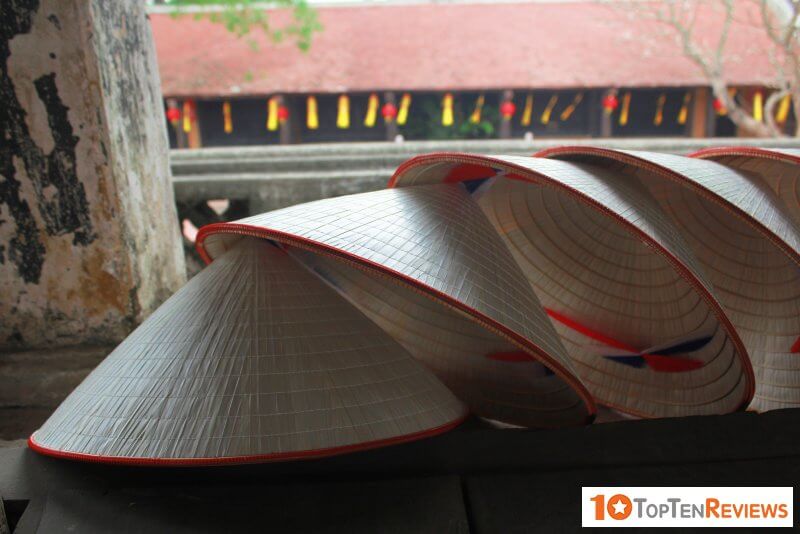
Vietnamese tried to make a hat modelling after the Goddess' by stitching together palm leaves, which is now known as Non la. The image of Non la has become strongly associated with peasant lives from the paddy field to boat men and women.
- What is the conical hat of Vietnam? (In Viet Nam, the nón lá ("leaf hat") forms a perfect right circular cone which tapers smoothly from the base to the apex. Special conical hats in Viet Nam contain colourful hand-stitch depictions or words while the Huế varieties are famous for their nón bài thơ (lit. poem conical hats).)
- Why do Vietnamese wear conical hats? (This hat was so large that it guarded the people against all the rain, and she was able to dispel the clouds and rain, allowing the people to return back to a normal life.)
How was Vietnamese Non la born?
The conical hat has gone through many ups and downs in Vietnamese history to be a symbol now. Because Vietnam is characterized by a humid tropical climate with frequent monsoon rains all year round, the people here have used the leaves together to form a hat to cover the rain and sun. The predecessor image of Non la was carved on the Ngoc Lu bronze drum, Dong Son bronze drum, and Dao Thinh bronze jar around 2,500 - 3,000 BC with the most rudimentary shape.
According to Vietnamese history, non la were born around the 13th century under the Tran Dynasty. People used it to make accessories for beautiful women, but the hat was thick and heavy. With the flow of time, non la becomes lighter and more elegant.
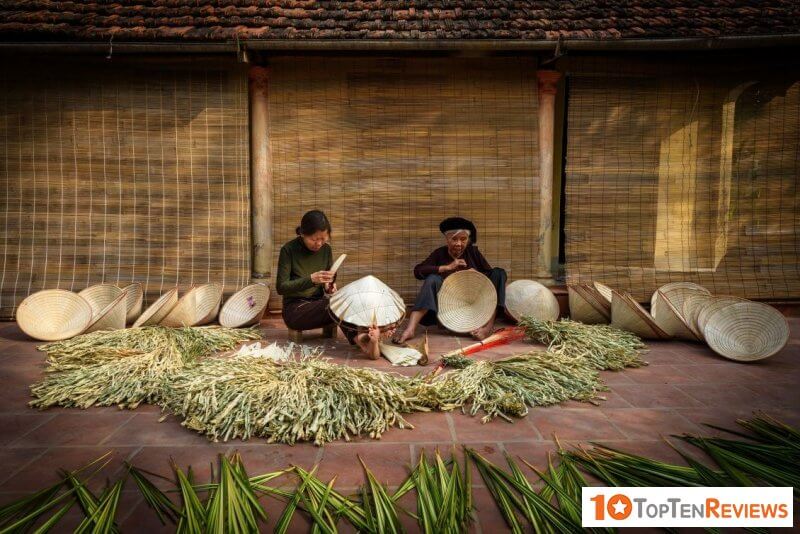
Revolving around the image of a hat also leaves many anecdotes with Vietnamese people. There is a story that the conical hat was born by a tall woman, on her head always wears a hat made of four round leaves, wherever the woman goes, the weather becomes favorable. After she taught people to grow wet rice, she disappeared. And to express gratitude to the Vietnamese people for building a temple in memory of the goddess and creating a similar cone pattern by stringing palm leaves together to become conical hats. The conical hat is called "non la" or "Non la Vietnam" based on the shape.
Despite many anecdotes and undergoing many transformations, Non la has become an indispensable item in the daily life of Vietnamese people for generations. Conical hats are handed down by Vietnamese descendants, entering both poetry and literature.
How to make conical hats?
The primary materials to make a hat are mainly leaves, bamboo stalks, thread, etc. The first step when making a hat is choosing leaves. Many types of leaves can be used to make cones. Vietnamese people often use coconut leaves or palm leaves. Coconut leaves must be obtained from the South, while palm leaves are abundant in the North. The leaves after harvest will be dried in the sun; then, the worker uses a heated iron to iron the leaves to make them flat. The temperature on the iron is just hot enough; otherwise, it will burn the leaves.
Next is the process of making molds, broaching the cones. The craftsman sharpens each bamboo spoke so that it is round evenly, especially with a minimum diameter so that it is easy to bend without breaking. A complete hat will have about 16 bamboo spokes turned into a circle from large to small arranged in a pyramidal frame. The number 16 is the study of many years by experienced artisans, becoming an unchanged principle when making hats.
After the leaves are dried flat and the conical mold is completed, people arrange about 24-25 leaves on top of each other in 2 layers, cut the head diagonally and sew together with a needle. In the middle, people use dried bamboo sheaths to make the hat fit rugged and durable. Folding leaves requires many techniques to make them even, not to be displaced, to create a thin bar.
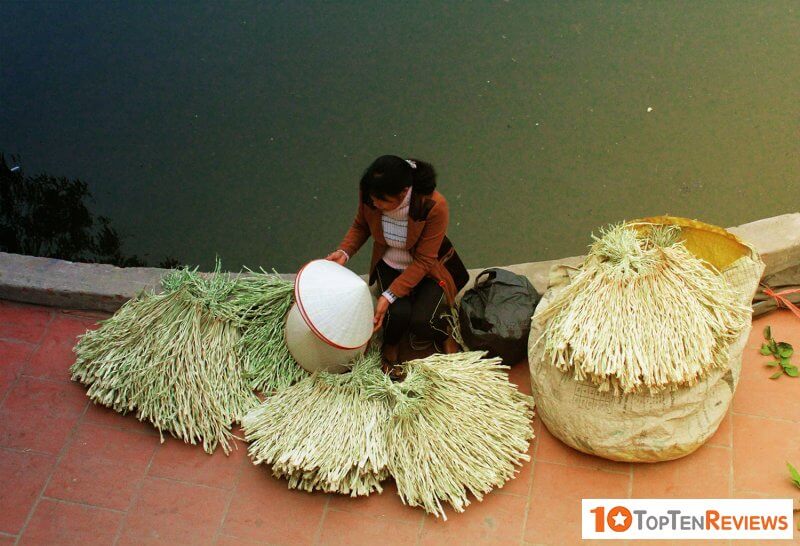
The final step is to sew the hat. The craftsman uses a thread and a sewing needle for gluing the cap (stitch each stitch through several layers to make sure) into a cone shape. Although there is no specific measurement, each stitch on the hat is neat, showing the ingenuity and professionalism of the hat maker. The stitching joints on the cap are also guaranteed to be perfectly concealed. After finishing the stitching, the craftsman will add on the top of the hat a "xoai" made of glossy thread to make the hat more beautiful. The hat is finished after being coated with a layer of shiny paint. This is a glossy plastic paint mixed with alcohol to have a transparent color to help rainwater not penetrate through the pinholes on the hat. Finally, the cap is dried to increase its durability.
In the hat, there are additional straps to create symmetry on both sides to help the wearer not fall off the non la.
Classification of Non la
Each region in Vietnam will have distinct conical hats such as Hue conical hats, which are usually thin and elegant, Western conical hats often use red thread, etc. After more than 3,000 years of appearance, Vietnamese conical hats have been. There are many versions, classified according to many uses.
In feudal times, people used conical hats with a top for animal soldiers; a knock hat is straw and used for soldiers. Vietnamese people in the North often used caps with straps as charms for women in the Middle Ages. From the twentieth century onwards, the strapless hat was not famous in daily life but mainly appeared in festivals. Nowadays, in Binh Dinh, horse hats are made of pandan leaves used when riding horses.
When it comes to Vietnamese conical hats, it is indispensable for poetic conical hats in Hue. On the non la, the craftsman skillfully inserts between two layers of leaves the poems or paintings. When non la is shined through the sunlight, it will clearly show the graphic features, especially the four poems inside. That's why the hat is called a "poem."
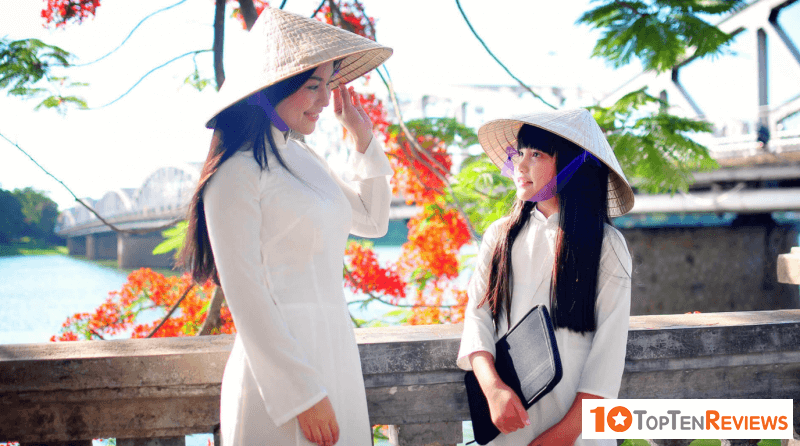
Preserving the value of Non la
Many conical hat villages in Vietnam were born to protect the image of conical hats. Each hat will have the characteristics of each region, but the common point is that they are all made by dedicated workers.
In the North, it is famous for making hats with Chuong conical village located about 40km from the center of Hanoi in Thanh Oai district, Hanoi. Bell hat was born in 1940, through many generations still maintains the traditional model - the conical hat. The unique feature of Chuong village's conical hat is that the leaves are "Lui," white leaves are taken from the mountainous areas of Thanh Hoa and Ha Tinh and are dried in the sun until they are silvery white.
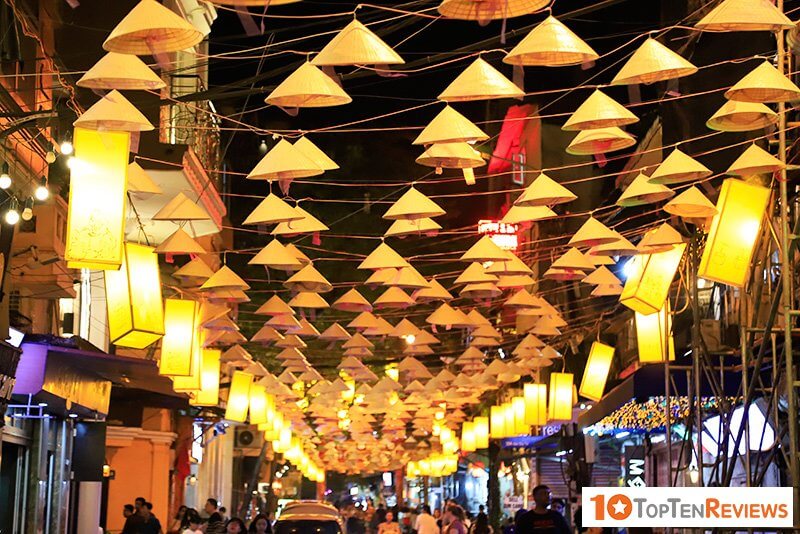
Along the central region, conical hats flourished in the ancient capital of Hue with many conical villages such as Da Le, Phu Cam, Doc So, etc. The characteristics of Hue conical hats are ordinary hats and works of art, the most unique of which is the "conical poem hat."
There is Thoi Tan hat in Can Tho in the South, about 70 years old, made of honey leaves and bamboo. This material makes the non la look smooth and durable. Thoi Tan villagers also divide hats into two types of market hats and field hats. The market hat is a more carefully selected type in the leaf stalk, much more elaborate than the field hat.
The meaning of Non la to Vietnamese people
A conical hat is made very elaborately and skillfully but only costs about 40,000 - 80,000 VND (1.75 - 3.51 USD), depending on the type. The value of the conical hat is not high, but we cannot measure its meaning to Vietnamese people. The conical hat is used for many purposes in life, so it has become a familiar item close to the life of Vietnamese people. In rural areas, mothers often use conical hats to go to the market or work in the fields. The conical hat is a symbol of the gentle and hardworking Vietnamese people with beautiful features in labor.
Vietnamese girls love to use conical hats as an accessory to accompany the ao dai. When used for decoration, Non la are usually light, neat, and sophisticated hats. Mainly the straps often use soft silk to make a perfect overall.

Vietnamese conical hats also appear in many exhibitions, in many art forms. In competitions from domestic to international, people often bring the image of the conical hat along with ao dai as the symbol of Vietnamese women.
Indeed when setting foot on the S-shaped strip of land, holding a conical hat in hand, each visitor will have exciting impressions and experiences.
